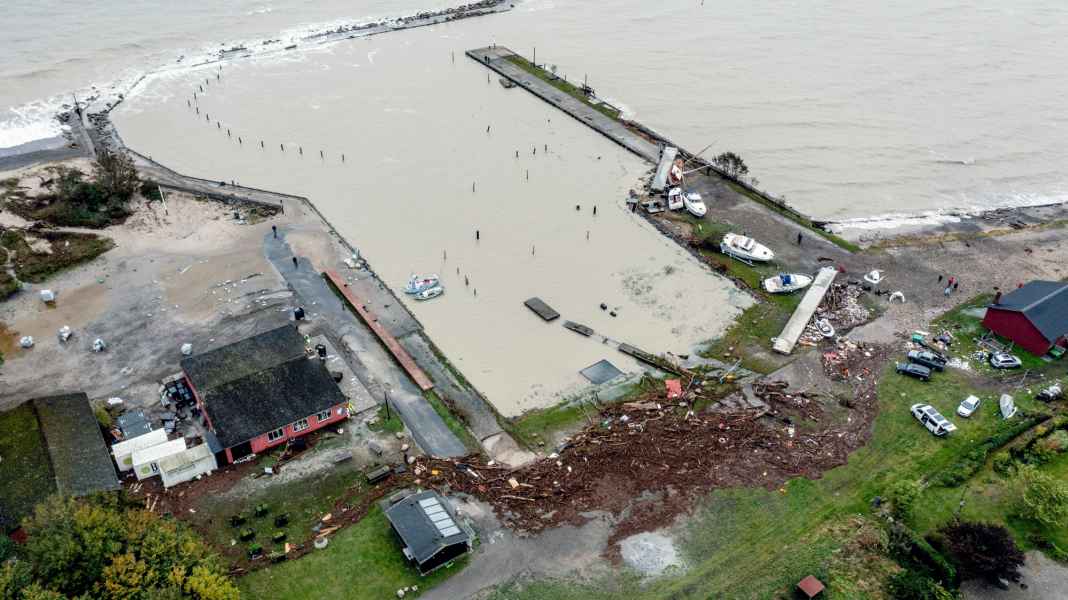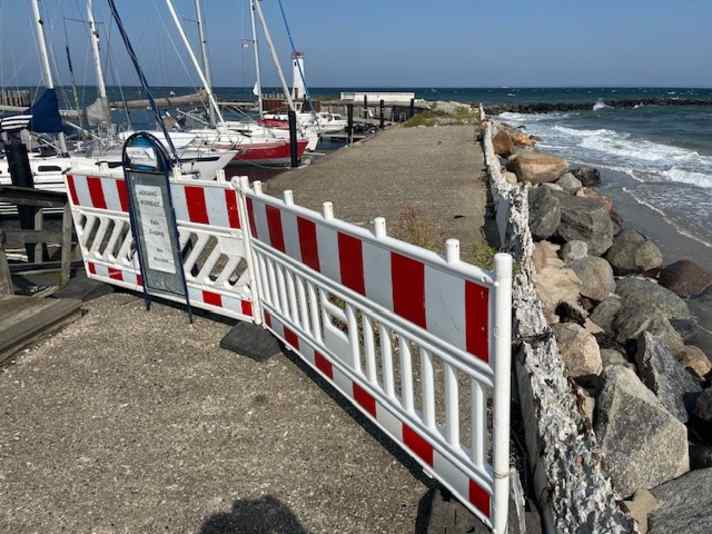Baltic Sea storm surge: Danish harbours between seasonal fiasco and new start
Fabian Boerger
· 11.09.2024

- Some storm surge damage still visible
- Denmark: Tense situation in private harbours
- No state aid, but great cohesion
- One step at a time
- Mommark: Fully open again since May
- "Many thought the harbour was closed"
- How sensible is the pier renewal?
- Gloomy mood in Hesnæs
- Harbour opening uncertain - possibly summer 2025
These were forces of a special kind: a devastating storm surge raged through parts of Schleswig-Holstein, Mecklenburg-Western Pomerania and south-east Denmark last October. In some places, the storm and waves tore holes in harbour piers, sank yachts, destroyed jetties and dolphins and washed away entire stretches of beach.
Most read about the storm surge:
That was almost a year ago. A lot has happened since then. Dykes have been repaired - for example in Arnis, which was particularly badly affected - or newly filled. Entire footbridges have been re-planked, piles driven in, electricity and water pipes laid and associated pillars repaired. This is what happened in Maasholm and Kiel-Schilksee. Everything so that the Nothing stands in the way of the 2024 season.
Some storm surge damage still visible
But there is another way. In Schleimünde, the pier still looks as if it has been hit by an explosive device. A few nautical miles away - in the marina in Damp - parts of the marina are still closed. Slightly less than a third of the 365 berths can currently be used.
More about the marina in Damp:
In addition, the costs there are exploding. The problem: the harbour has to be dredged for reconstruction and conversion, says Damper Mayor Barbara Feyock. However, the dredged material is contaminated by toxic substances from the boats and disposal is expensive and time-consuming.
Denmark: Tense situation in private harbours
If you look over to neighbouring Denmark, the situation is similar. The Danish Maritime Operators' Association put the damage caused by the storm surge at the beginning of this year at around twelve million euros. 59 harbours were affected. According to the association, the damage totalled 90 million kroner, around twelve million euros.
And what was already apparent in October is all the clearer today: the situation of some privately operated harbours in particular remains tense. As in Germany, they are not eligible for state subsidies. They have to pay for repairs to jetties, piers or the harbour basin largely out of their own pockets. For many, this is an immense hurdle.
No state aid, but great cohesion
For example in Avernakø - an island south of Funen and only a few nautical miles from Faaborg. The harbour is not owned by the municipality, but by the islanders. During the storm surge, the water here rose to over two metres above sea level. That is about 60 centimetres more than the height of the current pier. The water in the service building was almost half a metre high and the café on the harbour was also flooded.
Henning Storm, the harbour director at the time, tells the editorial team: "We are trying to manage the season as best we can." But the damage was serious, he says. Only the middle jetty in the rectangular harbour, which is enclosed by a pier, can now be used by guest berths. It can accommodate 40 yachts, 20 on each side. The local boats have been moved to the eastern jetty. A temporary solution, he says, as the damage there has only been repaired in a makeshift manner.
One step at a time
And the pitches on the west and north sides? Nothing can be done about them for the time being, says Storm. The storm surge has completely destroyed them. When will something change? Maybe next year? He doesn't know exactly. Now, in the autumn, the pier is to be raised by around half a metre and the east jetty renewed. The service building and café have also been renovated in the meantime.
The islanders expect the construction work to cost around 100,000 euros. They want to cover the majority of the costs through fundraising, but they have also asked for private donations. They have put up a flyer in the harbour to draw attention to their situation. So far, around 1000 euros have been raised, says Storm. Even more helpful, however, is the great private commitment. Storm: "A quarter of all the islanders have lent a hand in the harbour and helped for many days."
Mommark: Fully open again since May
The harbour in Avernakø is similar to others - for example the small marina in Mommark. It is also privately run and is open to the east. Carsten Kock took over the harbour from the municipality of Sønderborg in 2013. In November 2023, he estimated the damage at around eight to ten million kroner to the Danish television station TV Syd. He no longer hopes for state storm surge aid either, as the harbour and quay facilities are not insured.

In an interview with the editorial team, Kock explains that the season has gone well so far. One reason was the good weather at the end of August and beginning of September. This extended the season somewhat. However, he has noticed an overall decline of around 30 per cent. Part of this is the general decline, and he has heard similar reports from other harbours.
"Many thought the harbour was closed"
Another part could have a different reason, says Kock. "We were struck by the fact that many sailors thought the harbour was closed." Skippers were still calling him to enquire. The harbour had been open since mid-April with around half of the berths, and from May it was even completely open. In terms of catering and camping, everything is 100 per cent open again.
However, a different picture emerges for the jetties and the pier. The jetties have been put together as best as possible, but you can still clearly see the damage, says Kock. The breakwater is also still completely damaged. He has had to spend 600,000 euros on the work so far. Another 800,000 euros would be added for the pier and the jetties - costs that he would have to bear himself.
How sensible is the pier renewal?
He cannot understand why he does not receive any state support. In the case of recognised storm surges, the Danish Natural Hazard Council should have covered the damage instead of the insurance company. Municipal harbours have received a lot of money, says Kock. However, private harbour facilities or quays are on the authority's negative list and go away empty-handed.
More about the situation in Danish harbours:
Due to the costs and another project, the restoration of the destroyed pier is still uncertain. The harbour is to be extended. The plan is to create 180 new berths for pleasure craft and an industrial harbour. According to Kock, he and the investors already have the most important authorisations. The project is expected to cost 20 million euros and construction could begin in the next two to four years.
Gloomy mood in Hesnæs
And while there is a sense of optimism in Mommark and Avernakø, things remain rather gloomy in Hesnæs on the island of Falster. It is one of the worst-hit harbours in Denmark. Parts of the harbour were completely destroyed. This is one of the reasons why the stopover harbour, which is particularly popular with German water sports enthusiasts, remained closed this season.
Some are not deterred by this: "Although the harbour is closed, sailors still sail in," says Kristian Magnussen. According to the harbour master, this is not without danger, as there are still large boulders in the harbour basin. There is also the quay in the east of the harbour. Larger yachts in particular can moor alongside there. The concrete has broken up in several places.
Harbour opening uncertain - possibly summer 2025
There is no concrete plan for the next steps, says Magnussen. The first task is to clean the harbour basin. It will be cleared of stones and rubbish next spring. The idea of temporarily covering the damaged concrete quay with wood is also being discussed. According to Magnussen, it would cost a lot of money to restore the harbour to its original state. If everything goes according to plan, it should be open to pleasure boaters again next summer.

